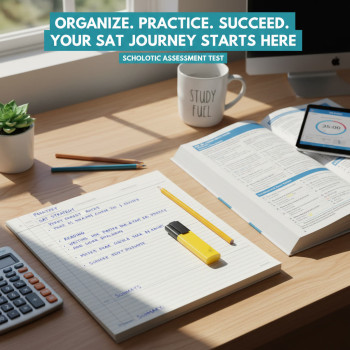When to Press Pause: Why Breaks Matter in SAT Prep
Preparing for the Digital SAT is a marathon, not a sprint. For many students, weeks and months of practice, timed sections, and essay drafts (depending on testing choices) become a steady drumbeat in the background of school, sports, and life. Parents watch, teachers encourage, and students push. But there’s a quiet danger: more practice isn’t always better practice. Knowing when to step back—fully, intentionally, without guilt—is a skill that protects long-term performance, mental health, and motivation.

The science and common sense behind breaks
Short, strategic breaks improve memory consolidation, reduce cognitive fatigue, and increase the quality of practice. Longer pauses—when you or your child are truly burned out—help reset motivation and prevent mistakes born from exhaustion. Think of study time as the engine and breaks as the oil that keeps it running smoothly; without both, the machine overheats.
How to Spot the Signs: Practical, Parent-Friendly Indicators
Burnout doesn’t always arrive dramatically. Often, it sneaks in as tiny changes in mood, focus, or behavior. Below are clear, observable signs that indicate it’s time to consider a break or to recalibrate the study plan.
Behavioral signals
- Loss of interest: Activities that used to be motivating—mock tests, high-score boards, or tutoring sessions—feel tedious or pointless.
- Procrastination spike: Assignments are delayed not because of time, but because staring at practice materials feels impossible.
- Withdrawal: The student becomes unusually distant, snapping at family or skipping activities they normally enjoy.
- Perfectionism or avoidance: Fixating on small mistakes or avoiding practice entirely out of fear of a low score.
Cognitive and study-quality signs
- Plateauing scores despite more hours: Practice minutes increase but progress stalls or declines.
- Shallow studying: Rushing through questions, skimming explanations, or failing to reflect on errors.
- Decreased retention: Concepts that were once understood are forgotten shortly after review.
Emotional and physical signals
- Heightened anxiety before practice or tests, sometimes with physical symptoms—tight chest, nausea, headaches.
- Sleep disruption: Trouble falling asleep due to worry, or needing naps during the day because of exhaustion.
- Chronic irritability or low mood that persists beyond the study session.
Real-Life Examples: What It Looks Like at Home
Concrete vignettes help turn abstract signs into real signals you can act on.
- Emma used to complete two practice sections a day; lately, she opens practice tests and closes the laptop after two questions. Her parents notice she’s binging shows more in the evenings and snapping at siblings. That combination—avoidance + mood shift—suggests she needs a structured break and a gentler routine.
- Ravi stays up late cramming and scores the same on practice tests each week. He tells his parents he’s studying more but feels foggier. This is a classic sign that study quality is declining and a schedule redesign with recovery time will help.
- Sophia has been jittery before every mock SAT and wakes up exhausted. Her schoolwork is slipping too. For Sophia, a break centered on sleep and reducing pressure around scores will likely yield better long-term gains.
How Long Should a Break Be?
There’s no universal duration. The right length depends on the severity of burnout, the test timeline, and the student’s personality. Below is a practical guide that helps match need to time.
| Type of Need | Suggested Break | What to Focus On During the Break |
|---|---|---|
| Minor fatigue / daily drag | Short—24 to 72 hours | Sleep hygiene, light physical activity, social time, one non-academic treat |
| Moderate burnout (avoidance, irritability) | 3–10 days | Reset routines, low-pressure review (flashcards, gentle reading), therapy or counseling if needed |
| Severe burnout (emotional/physical symptoms) | 2–6 weeks | Prioritize sleep, mental health support, significantly reduced or paused formal prep; reintroduce practice gradually |
| Pre-test cooldown (last week) | 3–7 days | Light review, practice with timing for a single section, relaxation strategies, logistical prep for test day |
What a Healthy Break Looks Like—Not Just Time Off, But Smart Recovery
Breaks aren’t empty time; they’re active recovery. The goal is to restore learning muscles so practice becomes effective again.
Key elements of a restorative break
- Sleep first: Make sleep a priority. Even a few nights of consistent 8–9 hour sleep can transform cognition and mood.
- Move your body: Light cardio, walks, or stretching reduce tension and improve focus when you return to studying.
- Reconnect socially: Time with friends or family decreases stress and reminds students there’s life beyond a single test.
- Do one low-stakes academic task: A 20-minute, no-pressure review (flashcards, reading a math concept) keeps skills warm without triggering stress.
- Reflect, don’t ruminate: Journaling about what’s working and what feels draining helps shape a smarter next-phase plan.

How Parents Can Help—Without Micromanaging
Supporting a teenager through SAT prep means balancing encouragement with respect for autonomy. Your role is to observe, validate, and gently guide.
Practical parent steps
- Normalize breaks: Talk openly about how everyone needs rest to perform their best—athletes, musicians, and students alike.
- Ask curious questions: “What part of prep feels the hardest right now?” is more helpful than “Why aren’t you studying?”
- Set boundaries together: Agree on clear start and stop times for study, and honor them. Model consistent unplugging, too.
- Help design the break: Offer options—are they ready for a full week off or a few afternoons with reduced pressure? Let them choose within a safe framework.
- Watch for red flags: If sleep, appetite, or mood changes are severe or prolonged, consider professional help. These are not things to power through alone.
Returning to Prep: A Gentle Reentry Plan
How you come back matters as much as the break itself. A rushed return invites relapse into burnout. Start small, focus on quality, and progressively increase intensity.
7-day reentry example plan
- Day 1–2: Light review—20–30 minutes of low-stakes work (flashcards, reading errors). No timed practice.
- Day 3–4: Targeted practice—one timed section at comfortable pacing. Review mistakes calmly.
- Day 5–6: Full practice test simulation if energy allows; otherwise two sections. Debrief the most meaningful 3–5 errors.
- Day 7: Rest or a short strategy session with a tutor/coach to set the next week’s plan.
When to Consider Professional Help
Sometimes a break and a plan aren’t enough. A tutor, counselor, or test prep coach can offer specialized support—especially when motivation, strategy, or test anxiety are the real barriers.
Who to turn to and why
- School counselor: For emotional support, college planning context, and help connecting with resources.
- Therapist or psychologist: If anxiety or mood issues significantly impair daily functioning.
- Experienced tutor or coach: To redesign a study plan, rebuild confidence with targeted practice, and provide accountability.
For families seeking tailored academic help, Sparkl offers personalized 1-on-1 guidance, tailored study plans, and expert tutors who blend human insight with AI-driven insights to track progress and adjust routines. That kind of targeted support can be exactly what a student needs after a break to restart effectively.
Practical Tools and Routines to Prevent Future Burnout
Prevention is better than cure. Adopt routines that keep study sustainable and enjoyable.
Weekly framework
- Limit long sessions: Keep daily focused study blocks to 60–90 minutes with built-in 10–20 minute breaks.
- Schedule a weekly digital detox: One evening or a full day that’s deliberately test-free.
- Rotate subjects: Alternate Math and Evidence-Based Reading & Writing to avoid cognitive monotony.
- Track progress in micro-metrics: Track error-type reduction rather than raw hours to see meaningful progress.
Daily checklist for sustainable prep
- Sleep: 8+ hours targeted.
- Movement: 20–30 minutes of physical activity.
- Nutrition: Balanced meals; avoid excessive caffeine during late study sessions.
- Reflection: 5–10 minutes of journaling—what went well, what to tweak tomorrow.
Common Myths About Breaks—Debunked
Misconceptions can keep families trapped in unhealthy cycles. Let’s clear a few up.
- Myth: “Taking time off will ruin progress.” Fact: Quality trumps quantity. Smart breaks optimize consolidation and prevent costly backslides.
- Myth: “Only week-long study marathons work.” Fact: Distributed practice with planned recovery outperforms marathon cramming for durable learning.
- Myth: “If you’re aiming for top schools, you must never stop.” Fact: Admissions officers expect balance and perseverance—not exhaustion. Healthy students perform better and present stronger application narratives.
Putting It Into Action: A Conversation Script for Parents and Teens
Here’s a short, scripted approach to start a gentle, constructive conversation when you suspect your child needs a break. Use your own words—this is just a template.
Parent: “I’ve noticed you seem more tired lately and that practice sessions feel frustrating. I care about how you’re feeling. Can you tell me what’s been the hardest part?”
Student: [listens, responds]
Parent: “Thank you for sharing. Would it help to try a short break—maybe two or three days—where you do one light review a day but otherwise focus on sleep and things you enjoy? We can make a plan together for when you come back.”
Student: [negotiates]
Parent: “Let’s try that, and we’ll check in at the end. If it still feels heavy, we can talk about bringing in someone to help redesign study time—like a tutor or counselor.”
Final Thoughts: Breaks Are Strategy, Not Surrender
Taking a break from SAT prep is not giving up. It’s a strategic, evidence-informed move that honors the way learning and recovery work together. Students who learn to listen to their minds and bodies—who alternate focus with rest—arrive on test day clearer, calmer, and more capable.
As a parent, your steady presence, your willingness to listen, and your support for smart decisions will matter more than any extra hour of late-night practice. And if you ever need help rethinking the plan, a tailored tutor or coaching service (including Sparkl’s personalized 1-on-1 guidance and AI-informed study plans) can provide the structure and encouragement to rebuild momentum without pressure.
Remember: the goal of SAT prep is to reveal and strengthen potential—not to break the student. Pause when needed, return with intention, and keep the bigger picture in view: a healthy, curious, confident student ready for college and beyond.
Quick Checklist: Should We Pause?
- Are practice scores flat despite increased hours? Pause and reassess.
- Is your teen avoiding materials they used to enjoy? Consider a 3–10 day break.
- Are sleep, appetite, or mood significantly affected? Consult a health professional and take an extended break.
- Does the student feel motivation returning after a short pause? Use that momentum to reintroduce structured practice.
By tuning into these signs and responding with compassion and strategy, families can turn a stressful season into an opportunity for growth—and help students approach the Digital SAT with sharper minds and fuller lives.
















No Comments
Leave a comment Cancel